Meats and Sausages
Vodka Production
Vodka can be made by distillation or by mixing alcohol with fruit juices.
1. Distillation.
- Distilling fermented grains, potatoes or fruits (fermentation is involved). This method is not recommended for a hobbyist as it is illegal in the USA to distill any type of alcohol at home.
- Distilling fruit infusions (no fermentation is involved). This method is also not recommended for a hobbyist as it is illegal in the USA to distill any type of alcohol at home.
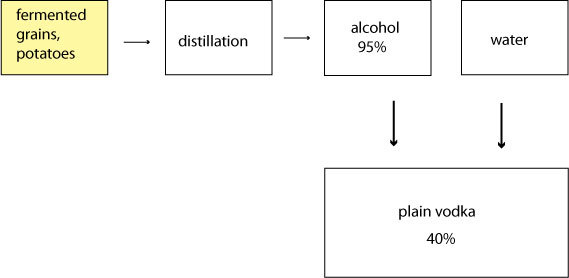
Plain vodka.
It takes about 1 ml (5 drops) of a good essential oil to flavor 10 liters of vodka. All distilled essential oils are clear so it is easy to recognize such a spirit. For example many flavored vodkas such as caramel, cucumber, cherry and others are clear which is a questionable tactic. When I drink cherry vodka, I want it to be red. You wouldn't want to drink clear coffee, would you?
Commercial producers solve the problem by adding officially approved food colorings.
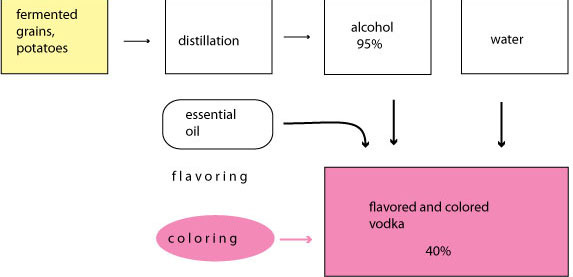
Flavored and colored vodka.
1. Distilling Fermented Fruit, Grains or Alcoholic Infusions. The first half of the process is similar to making wine. Let us assume that we have made grape wine and we want to distill it. Once it is distilled its name suddenly changes to English brandy, Polish winiak or if it were produced from grapes growing in the town of Cognac, it can be legally called Cognac. Yet it is just distilled white grape wine. Call it grape vodka if you like.
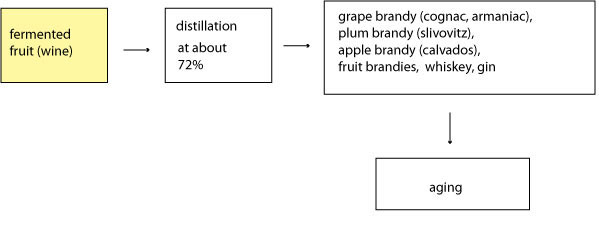
Natural Distilled Fruit Vodka or Liqueur.
As you can make wine from almost any fruit, a strong flavored spirit can be obtained by distilling the fermented mash. If distillation were proceeding at full strength, the result will be 96.5% alcohol and 3.5% water, without any dominant flavor. All distilled spirits are clear, they owe their color to:
- Flavoring, for example caramel.
- Maturing in oak barrels (brandy, cognac) where they receive their color from the wood. A simplified method of creating this type of color in home conditions is adding oak wood chips into the spirit.
Distilled spirits that must remain clear will be aged in clay or glass containers. Different fruits will impart a different flavor to the distillates, some of which are listed below:
- Grape Brandies: Brandy, Armagnac, Cognac, Polish Winiak
- Fruit Brandies: Apple (Calvados), Plum (Slivovitz), Sour Cherry (Kirsch)
- Grain Spirits: Rye (Rye Vodka), Corn (American Whiskey), Barley (Scotch Whiskey), Rice (Arak)
- Molasses: Sugar cane (Rum)
Someone might say: yes, but does distillation result in pure alcohol without taste or flavor? Yes, it does but only if you want it to. The reason that pure alcohol has no taste is that we have removed everything we possibly could including substances responsible for flavor. If we control the distillation process in such a way that it produces 60-75% alcohol, the distillate will be composed of alcohol, water, plus all those substances that stamp the product with its characteristic taste and flavor. Cognac, which is distilled white grape wine, cannot be made stronger than 72% otherwise it will lose all those flavors that make it what it is. By distilling fermented fruit mash to about 60-75% we obtain a distillate that is used for making flavored vodkas. Such a distillate contains essential oils, flavor substances, fats, proteins, acids and color substances which evaporated together with alcohol and subsequently were cooled down to form a distillate. They contribute to the flavor of the alcoholic spirit. If the same fermented fruit mash were distilled to 95% we would obtain a pure neutral tasting alcohol which is devoid of all those flavor creating compounds. It becomes evident now that all distilled spirits like brandy, whisky, gin, or rum must be distilled to the alcohol strength that will allow flavor compounds to escape with alcohol vapors and become a part of the distillate.
Most distillates undergo a maturing process for a couple of years for their taste and flavor to mellow. The distillate will lose some strength through alcohol evaporation. Most spirits are kept in oak barrels and these are tight enough to prevent leaks, nevertheless alcohol vapors are still able to get through. They may be 60% strength when submitted for the final tests before bottling. Then they will be diluted with water to 40% and flavored vodkas would be created. In time the distillate which is aged in oak casks acquires a brown color typical to cognac, brandy or whiskey. This should be kept in mind as it will influence the final color of the spirit. A customer would not want to drink brown gin, that is for sure.
Distilling InfusionsGenerally any fruit infusion can be distilled to make fruit flavored alcohol. The process is similar to making the first infusion method: fruit preparation, adding alcohol and maceration. The maceration process lasts only about 12 hours and the infusion is then distilled. The resulting vodka will be clear. You can throw fry juniper berries to alcohol for a few days and then distill it. The resulting spirit is gin.
2. Making Vodkas by Mixing Method.
Mixing alcohol with infusions, juices, sugar and other ingredients. This is the second method that commercial producers once used for making flavored vodkas and other spirits. Here a hobbyist can do anything in his apartment that a brewery does, and the results may be even better. The only difference is the brewery produces its own 95% alcohol and the hobbyist will buy 95% or 75% alcohol from a store. Flavored vodkas are made by mixing pure alcohol with flavor essences, colorings and water in such a proportion that around 40% (80-proof) flavored spirit is obtained.This method produces wonderful fruit vodkas, however it is too costly and time consumming for a commercial producer. In addition it requires a lot of designated space.
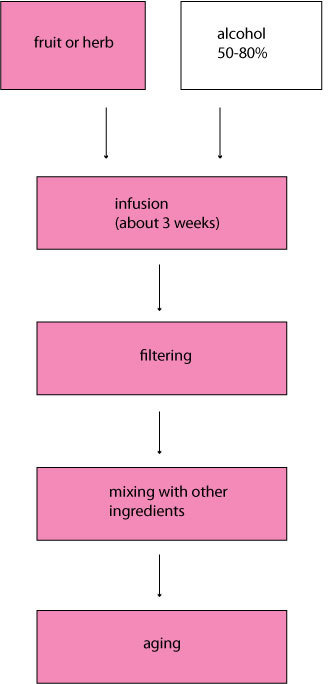
Natural fruit vodka.
There is very little difference between infusion and vodka. Vodkas are usually 40% strong; an infusion can be made of any strength. Infusions having an alcohol content below 40% can still be used for vodkas as alcohol can be added to increase the strength. However, it is recommended to make such infusions with fruit and alcohol only. The common practice in traditional recipes is to mix sugar, fruit and alcohol on day one. It will be difficult to calculate the strength and sweetness of vodka if sugar based infusions were mixed together. Another problem is that you cannot produce dry vodka from a sweet infusion and not everybody is fond of sweet spirits.
The process of making flavored vodkas is based on mixing materials such as:
- 95% or 75% alcohol. It may be difficult to purchase 95% alcohol in the USA, but the 75% version is available.
- Infusions.
- Alcohol juices.
- Fresh fruit juices.
- Sugar syrup.
- Essential oils.
- Herbs and spices or their infusions.
- Adding saffron, caramel or colorants.
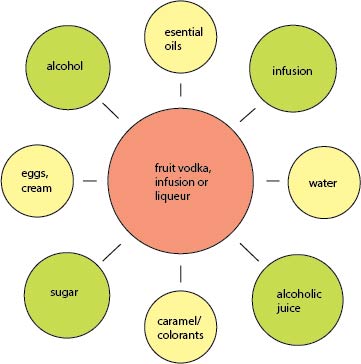
Making natural fruit vodka.
Different types of vodka that may be produced at home by the mixing method:
- Plain vodkas - dry vodkas made from a store bought distillate. They may contain some flavoring such as juniper, pepper, bison grass and a very small amount of sugar, usually less than 5 g/l.
- Fruit vodkas - Rowan, Blackthorn (Sloe plum), Juniper, Plum, Green Walnut, Orange, Lemon, Mango, Plum, Cherry, Sour Cherry, Apple, Pear, Peach etc.
- Herbal dry or sweet vodkas - Pepper, Red Pepper, Bison Grass (Zubrowka).
- Herbal bitter vodkas - Magenbitter, Boonekamp, English Bitter, Polish Bitter, Angostura. This type is credited with helping digestion. These are modern versions of traditional tincures and are taken for their medicinal value, usually one or two drinks before the meal.
- Gin - gin can be made by simply flavoring alcohol with juniper berries without involving distillation. The infusion may be enhanced by adding sugar, dry citrus skins or Angelica archangelica root.
Fruit infusions can be classified as fruit vodkas as long as their strength remains around 40%. Many commercially produced dry vodkas such as gin, brandy, and orange vodka require distillation which is illegal outside the industry. Because of that our discussion is limited to making vodkas by the infusion method. The infusion method will produce a wonderful product, however, depending on the fruit selected, the clarity of the spirit may vary.
Sweet Vodkas
Vodkas in this group can be made from any available fruit, contain more sugar and appeal to more customers. Very often they combine a few fruits together and go by the name "ratafia." Adding 5-30% sugar (50-300 g/liter) produces sweet vodkas, but this is of course a loosely defined limit. There is little distinction between sweet vodka and alcoholic fruit infusion, what separates the two is the alcohol strength. Similarly to wine, the sweeter the vodka the darker its color. It is recommended to add around 0.01% (0.1 g/l) of citric acid to sweet vodkas as this offsets some of the sweetness and smoothens the flavor.
Use of Extracts and Essential Oils
General guidelines:
Essential oils should be considered just another tool for making spirits. Infusions produce much better vodkas than using extracts or oils alone. Infusion is the wrench and essential oil is just a socket. Oils supply plenty of aroma, but infusions carry more of the fruit's natural flavor. Caraway vodka made by the infusion process carries its own natural color and tastes better than the clear caraway vodka that was produced with caraway oil alone. In addition, each fruit or herb stamps the infusion with its natural flavor, for example papaya infusion retains papaya's color and the same is true with cherry, strawberry and other infusions. Surprisingly, white and pink grapefruits turn out crystal clear.
Nevertheless, a small collection of essential oils becomes a powerful weapon in your arsenal. Every popular herb and spice can be obtained in the form of essential oil so they become of great value for experimenting with bitter vodkas or herbal liqueurs. They can be added at any time to boost the flavor of the infusion. Let's say you have a peppermint infusion. It has an acceptable color but you feel that it lacks some mint flavor. All you need to do is add a drop or two of peppermint oil and the aroma will be much stronger. Generally, you do not need more than 1/2 ml of essential oil for 1 liter of infusion to magnify the flavor.

















